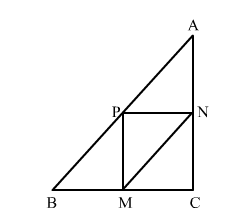A square is inscribed in an isosceles right triangle so that the square and the triangle have one angle common.
Question:
A square is inscribed in an isosceles right triangle so that the square and the triangle have one angle common. Show that the vertex of the square opposite the vertex of the common angle bisects the hypotenuse.
Solution:

Given: In an isosceles right ∆ABC, CMPN is a square.
To prove: P bisects the hypotenuse AB i.e., AP = PB.
Proof:
In square CMPN,
∴ CM = MP = PN = CN (All sides are equal.)
Also, ∆ABC is an isosceles with AC = BC.
⇒ AN + NC = CM + MB
⇒ AN = MB (∵ CN = CM) ...(i)
Now,
In ∆ANP and ∆PMB,
AN = MB [From (i)]
∠ANP = ∠PMB = 90°
PN = PM (Sides of square CMPN)
∴ By SAS congruence criteria,
∆ANP ≅ ∆BMP
Hence, AP = PB (By CPCT)
